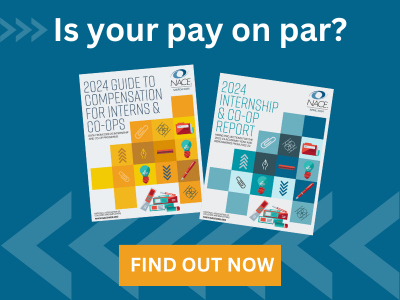Spotlight for Recruiting Professionals
It is important for employers to consider the language they use because language matters, language can be loaded, and language can have different meanings for different people, says April Rinne, global authority on the new economy, future of work, and navigating constant change.
“A lot of people don’t mean the same thing when they say a particular word, or they’re saying it in a way that’s loaded with their own perspective and history that the person they’re speaking to may—but often does not—share,” explains Rinne, who was a keynote speaker during the NACE21 conference in June.
“This can lead to all kinds of tension, awkwardness, and misunderstandings. Sometimes it’s impossible to find one common definition, but there’s a lot we can do to be more thoughtful and inclusive in our language.”
Rinne points to the use of the phrase “talent acquisition,” which is used commonly in the college recruiting field, to illustrate how subtle changes in the use of language can impact organizational culture and an existing “ownership mentality.”
“When you look at the term ‘talent acquisition,’ to acquire talent is very much an employer perspective,” she says.
“The verb ‘acquire’ means to own, to get as one’s own, and to come into possession or control. When considered from a worker’s perspective, the concept of being possessed and controlled isn’t appealing.”
On the other hand, she continues, “engage” means to offer something as backing to a cause or aim, to support something, or to encourage someone to do something.
“Employees want to be engaged, not acquired,” Rinne notes.
“The same goes for ‘attraction,’ which means to entice and also is a better choice than ‘acquisition.’ We have normalized a lot of words in our language, yet when you break it down, you see that there’s a power dynamic at play. I don’t believe that’s what employers wish to convey. I don’t think they mean that they want to possess and control and own their employees, but the reality is that’s what ‘acquisition’ means.”
“Attraction” and “engagement” are empowering words for talent, she says, and they represent a very different power dynamic: one more akin to peers and allies.
“Importantly,” Rinne continues, “employers can signal that they see their employees and talent as having agency, as being a whole person, and having an equal place in the workplace. It’s uplifting, and if an employer wants to inspire and uplift its employees, it should use language that is inspiring and uplifting from their perspective.
“By using this language, the employer is signaling that its employees retain some personal agency and independence. It’s inviting them into a more collaborative work environment and saying that it is not going to dictate everything the employee does. Employees want to feel that they have independence for their thinking and in the ways they express themselves, and that they have the freedom to be creative and innovative. This language also makes it clear that the organization values its employees’ agency and fresh perspective.”
Rinne says there are many words that can achieve the same goal, but employers should always opt to use language that is more human-centric and employee-friendly.
“Particularly in a workplace where we are worried about, for example, employees being overworked,” she says.
“When organizations make the dynamic such that they have control over every hour of the employees’ day, this language starts to take on additional weight and can have ripple effects. That feeds into the organizational culture.”
Furthermore, employers seeking to create more diverse, equitable, and inclusive work environments should use language that is welcoming to incoming talent.
“The ripple effects are the diversity and the equity that are related to—and can be further fostered by—using language that treats everyone as having equal agency,” Rinne points out.
“It’s subtle, but there’s a feeling that everyone wants to be there, they’re opting in to be there, and more people are accepted there if this is how we see and treat one another. This feeds directly into organizational culture.”
Organizations hoping to ensure any changes to language have been fully made can take steps, such as reviewing and changing communications, marketing materials, and the website.
“There are formal and informal levers here,” Rinne says.
“The formal is how does an organization define its values? On the surface, what is the language it’s using in job descriptions, in offer letters, in HR manuals, press releases, and more? Is the organization walking the talk? This is top to bottom. If leadership is doing or saying one thing, but middle managers are doing or saying another, then obviously that creates friction. In my experience, leadership often seems to understand the importance of language, but it hasn’t necessarily filtered down into policy manuals and so forth. It tends to get caught somewhere in the middle where employees are trying to manage up and down so there’s more of a control dynamic at play. This means the changes don’t make it to younger and incoming talent.”
To identify snags, Rinne recommends that organizations do an audit of the language they use throughout the organization, then fix it where it needs repairs. She says it is in the informal levers where the changes really play out.
“It’s in modeling that language and pushing it out that makes the difference,” Rinne notes.
Employers that do not pay attention to or evolve the language they use run myriad risks. Some are on the surface and show up in the language the organization uses in, for example, in press releases or on its website.
“There’s enormous reputational risk to an organization’s goodwill and competitive standing in the marketplace,” she says.
“If an employer’s peers and competitors are using more inclusive language and signaling very clearly that they see everyone as having agency and independence, and that work isn’t about having control over someone, talent picks up on that and will track into those companies that are using the more empowering language. This issue runs much deeper than optics, but the optics do matter, especially when trying to engage top talent. It will impact the organization’s visibility and perception within the marketplace.”
Rinne also suggests that employers not only consider, but also engage, the audiences they are trying to reach when developing marketing materials.
“They need to be able to stand in the shoes of other people,” she says.
“They need to read the language they are using from the perspective of the people they are trying to reach. The key is for them to make themselves a little vulnerable, and here I use ‘vulnerable’ as a strength. It requires being humble and asking the people the organization is seeking to attract if it has the language and message right.”
Rinne says this is demand-driven research that is best conducted through surveys and focus groups as opposed to simply assuming that an employer’s marketing or HR teams know what language to use.
Says Rinne: “Many people want to help ensure that language is inclusive, and many people want to bring a healthy, fresh perspective for how we can do things better. There are win-win opportunities to do this all around.”






